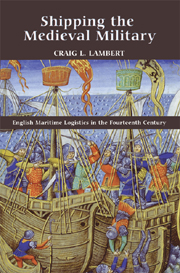Book contents
- Frontmatter
- Contents
- List of Tables
- Acknowledgments
- Abbreviations
- Introduction
- 1 Raising a Fleet
- 2 The Supply of Armies and Garrisons by Sea, 1320–1360
- 3 The Transportation of English Armies to France, 1324–1360
- 4 Maritime Resources and the King's War
- Conclusion
- Appendix 1 Ports that Supplied Ships to the Fleets
- Appendix 2 Reconstructing the Merchant Fleet: A Methodology
- Bibliography
- Index
- Warfare in History
4 - Maritime Resources and the King's War
Published online by Cambridge University Press: 12 September 2012
- Frontmatter
- Contents
- List of Tables
- Acknowledgments
- Abbreviations
- Introduction
- 1 Raising a Fleet
- 2 The Supply of Armies and Garrisons by Sea, 1320–1360
- 3 The Transportation of English Armies to France, 1324–1360
- 4 Maritime Resources and the King's War
- Conclusion
- Appendix 1 Ports that Supplied Ships to the Fleets
- Appendix 2 Reconstructing the Merchant Fleet: A Methodology
- Bibliography
- Index
- Warfare in History
Summary
This book has set out to investigate the involvement, whether voluntary or unwillingly, of England's maritime communities to the war effort of Edward II and Edward III. The analysis so far has shown the numbers of ships, mariners and ports that were involved in the maritime dimension of the wars. The origins of the participation of so many ports, and their resources, in the wars of the period can be traced back to the campaigns conducted under Edward I, especially those of the 1290s in Scotland and Flanders. Although Edward II's Scottish campaigns were punctuated by long periods of truce the requisitioning of ships continued regularly. But by the time of Edward III's campaigns, particularly those fought on the continent from 1338 onwards, a dramatic change occurred in the organisation and logistics of war. Edward I and Edward II had raised only four fleets for service abroad (the St Sardos fleet has been counted as two), but within four years from 1338 Edward III had already matched this.
What this study has shown is that in terms of ship numbers the scale of the operations from the beginning of Edward III's reign increased dramatically. Edward II's fleet of 284 ships serving in the campaign of 1322 looks rather small as compared with the 675 vessels that Edward III deployed throughout 1342. Change also occurred in the organisation of the fleets. In the Scottish wars ships could be requisitioned and put to sea in relatively small numbers over the course of perhaps a month, which in turn led to large numbers of vessels sailing the seas around Scotland.
- Type
- Chapter
- Information
- Shipping the Medieval MilitaryEnglish Maritime Logistics in the Fourteenth Century, pp. 156 - 206Publisher: Boydell & BrewerPrint publication year: 2011



